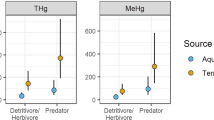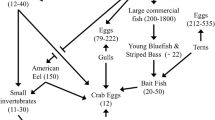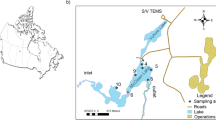Abstract
Resource managers are concerned that water conservation practices in irrigated farmlands along the southern border of the Salton Sea, Imperial County, California, could increase selenium concentrations in agricultural drainwater and harm the desert pupfish (Cyprinodon macularius), a federally protected endangered species. As part of a broader attempt to address this concern, we conducted a 3-year investigation to collect baseline information on selenium concentrations in seven agricultural drains inhabited by pupfish. We collected water, sediment, selected aquatic food-chain taxa (particulate organic detritus, filamentous algae, net plankton, and midge [Chironomidae] larvae), and two poeciliid fishes (western mosquitofish Gambusia affinis and sailfin molly Poecilia latipinna) for selenium determinations. The two fish species served as ecological surrogates for pupfish, which we were not permitted to sacrifice. Dissolved selenium ranged from 0.70 to 32.8 μg/L, with selenate as the major constituent. Total selenium concentrations in other environmental matrices varied widely among drains, with one drain (Trifolium 18) exhibiting especially high concentrations in detritus, 5.98–58.0 μg Se/g; midge larvae, 12.7–50.6 μg Se/g; mosquitofish, 13.2–20.2 μg Se/g; and mollies, 12.8–30.4 μg Se/g (all tissue concentrations are based on dry weights). Although toxic thresholds for selenium in fishes from the Salton Sea are still poorly understood, available evidence suggests that ambient concentrations of this element may not be sufficiently elevated to adversely affect reproductive success and survival in selenium-tolerant poeciliids and pupfish.


Similar content being viewed by others
References
Bennett, J. (1998). Biological effects of selenium and other contaminants associated with irrigation drainage in the Salton Sea area, California, 1992–1994. US Department of the Interior, National Irrigation Water Quality Program, Information Report 4, Washington, DC. http://www.usbr.gov/niwqp/pdf/bibliography_reports/bennett1998_saltonsea.pdf. Accessed 25 January 2011.
Canton, S. P., & Van Derveer, W. D. (1997). Selenium toxicity to aquatic life: an argument for sediment-based water quality criteria. Environmental Toxicology and Chemistry, 16, 1255–1259.
DeForest, D. K., Brix, K. V., & Adams, W. J. (1999). Critical review of proposed residue-based selenium toxicity thresholds for freshwater fish. Human and Ecological Risk Assessment, 5, 1187–1228.
Gao, S., Tanji, K. K., Peters, D. W., Lin, Z., & Terry, N. (2003). Selenium removal from irrigation drainage water flowing through constructed wetland cells with special attention to accumulation in sediments. Water, Air, and Soil Pollution, 144, 263–284.
Hamilton, S. J. (2002). Rationale for a tissue-based selenium criterion for aquatic life. Aquatic Toxicology, 57, 85–100.
Hothem, R. L., & Ohlendorf, H. M. (1989). Contaminants in foods of aquatic birds at Kesterson Reservoir, California, 1985. Archives of Environmental Contamination and Toxicology, 18, 773–786.
Janz, D. M., DeForest, D. K., Brooks, M. L., Chapman, P. M., Gilron, G., Hoff, D., et al. (2010). Selenium toxicity to aquatic organisms. In P. M. Chapman, W. J. Adams, M. L. Brooks, C. G. Delos, S. N. Luoma, W. A. Maher, et al. (Eds.), Ecological assessment of selenium in the aquatic environment (pp. 141–231). Boca Raton: CRC.
Lemly, A. D. (1993). Guidelines for evaluating Se data from aquatic monitoring and assessment studies. Environmental Monitoring and Assessment, 28, 83–100.
Lemly, A. D. (2002). Selenium assessment in aquatic ecosystems; a guide for hazard evaluation and water quality criteria. New York: Springer.
Martin, B. A., & Saiki, M. K. (2009). Trophic relationships of small nonnative fishes in a natural creek and several agricultural drains flowing into the Salton Sea, and their potential effects on the endangered desert pupfish. The Southwestern Naturalist, 54, 156–165.
May, T.W., Walther, M.J., & Brumbaugh, W.G. (2006). Determination of selenium in samples collected from Salton Sea irrigation drains in April and July 2006. Columbia: US Geological Survey, Columbia Environmental Research Center, Final Report FY06-32-04. 55 pp.
May, T.W., Walther, M.J., & Brumbaugh, W.G. (2007a). Selenium concentrations in irrigation drain inflows to the Salton Sea, California, October 2006 and January 2007. US Geological Survey Open-File Report. 2007–1113. 18 pp. http://pubs.usgs.gov/of/2007/1113/pdf/OFR2007-1113.pdf. Accessed 25 January 2011.
May, T.W., Walther, M.J., Saiki, M.K., & Brumbaugh, W.G. (2007b). Total selenium and selenium species in irrigation drain inflows to the Salton Sea, California, April and July 2007. US Geological Survey Open-File Report. 2007–1347. 18 pp. http://pubs.usgs.gov/of/2007/1347/pdf/OFR2007-1347.pdf. Accessed 25 January 2011.
May, T.W., Walther, M.J., Saiki, M.K., & Brumbaugh, W.G. (2008). Total selenium and selenium species in irrigation drain inflows to the Salton Sea, California, October 2007 and January 2008. US Geological Survey Open-File Report. 2008–1178. 14 pp. http://pubs.usgs.gov/of/2008/1178/pdf/OFR2008-1178.pdf. Accessed 25 January 2011.
May, T.W., Walther, M.J., Saiki, M.K., & Brumbaugh, W.G. (2009a). Total selenium and selenium species in irrigation drain inflows to the Salton Sea, California, October April and July 2008. US Geological Survey Open-File Report. 2009–1011. 17 pp. http://pubs.usgs.gov/of/2009/1011/pdf/OF2009_1011.pdf. Accessed 25 January 2011.
May, T.W., Walther, M.J., Saiki, M.K., & Brumbaugh, W.G. (2009b). Total selenium and selenium species in irrigation drain inflows to the Salton Sea, California, October 2008 and January 2009. US Geological Survey Open-File Report. 2009–1123. 14 pp. http://pubs.usgs.gov/of/2009/1123/pdf/OF2009_1123.pdf. Accessed 25 January 2011.
Moyle, P. B. (2002). Inland fishes of California; revised and expanded. Berkeley: University of California.
Orr, P. L., Guiguer, K. R., & Russel, C. K. (2006). Food chain transfer of selenium in lentic and lotic habitats of a western Canadian watershed. Ecotoxicology and Environmental Safety, 63, 175–188.
Saiki, M. K., & Ogle, R. S. (1995). Evidence of impaired reproduction by western mosquitofish inhabiting seleniferous agricultural drainwater. Transactions of the American Fisheries Society, 124, 624–635.
Saiki, M. K., Jennings, M. R., & Brumbaugh, W. G. (1993). Boron, molybdenum, and selenium in aquatic food chains from the lower San Joaquin River and its tributaries, California. Archives of Environmental Contamination and Toxicology, 24, 307–319.
Saiki, M. K., Martin, B. A., & May, T. W. (2004). Reproductive status of western mosquitofish inhabiting selenium-contaminated waters in the Grassland Water District, Merced County, California. Archives of Environmental Contamination and Toxicology, 47, 363–369.
Saiki, M.K., Martin, B.A., & May, T.W. (2010). Final report: baseline selenium monitoring of agricultural drains operated by the Imperial Irrigation District in the Salton Sea Basin, California. US Geological Survey Open-File Report. 2010–1064. 100 pp. http://pubs.usgs.gov/of/2010/1064/pdf/ofr20101064.pdf. Accessed 25 January 2011.
Schroeder, R. A., Orem, W. H., & Kharaka, Y. K. (2002). Chemical evolution of the Salton Sea, California: nutrient and selenium dynamics. Hydrobiologia, 473, 23–45.
Setmire, J. G., & Schroeder, R. A. (1998). Selenium and salinity concerns in the Salton Sea area of California. In W. T. Frankenberger Jr. & R. A. Engberg (Eds.), Environmental chemistry of selenium (pp. 205–221). New York: Marcel Dekker.
Stewart, R., Grosell, M., Buchwalter, D., Fisher, N., Luoma, S., Mathews, T., et al. (2010). Bioaccumulation and trophic transfer of selenium. In P. M. Chapman, W. J. Adams, M. L. Brooks, C. G. Delos, S. N. Luoma, W. A. Maher, et al. (Eds.), Ecological assessment of selenium in the aquatic environment (pp. 93–139). Boca Raton: CRC.
Sundberg, S. E., Hassan, S. M., & Rodgers, J. H., Jr. (2006). Enrichment of elements in detritus from a constructed wetland and consequent toxicity to Hyalella azteca. Ecotoxicology and Environmental Safety, 64, 264–272.
USEPA (2004). Draft aquatic life water quality criteria for selenium—2004: Washington, DC, Office of Science and Technology, EPA-822-D-04-001. http://earth1.epa.gov/waterscience/criteria/selenium/pdfs/maintext.pdf. Accessed 25 January 2011.
Wisconsin Department of Natural Resources (2003). Consensus-based sediment quality guidelines; recommendations for use and application interim guidance. Madison, WI, WT-732 2003, 35 p. http://dnr.wi.gov/org/aw/rr/technical/cbsqg_interim_final.pdf. Accessed 25 January 2011.
Young, T. F., Finley, K., Adams, W. J., Besser, J., Hopkins, W. D., Jolley, D., et al. (2010). What you need to know about selenium. In P. M. Chapman, W. J. Adams, M. L. Brooks, C. G. Delos, S. N. Luoma, W. A. Maher, et al. (Eds.), Ecological assessment of selenium in the aquatic environment (pp. 7–45). Boca Raton: CRC.
Zawislanski, P. T., Chau, S., Mountford, H., Wong, H. C., & Sears, T. C. (2001). Accumulation of selenium and trace metals on plant litter in a tidal marsh. Estuarine & Coastal Shelf Science, 52, 589–603.
Acknowledgments
The authors are grateful to the Imperial Irrigation District (IID) and the USGS Fisheries: Aquatic and Endangered Resources Program for funding the work described in this report. Bruce Wilcox of IID assisted with contract management and provided invaluable logistical support. Jeff Tupen, Harry Ohlendorf, and members of the IID Implementation Team provided project guidance and technical oversight. James Fairchild and Harry Ohlendorf reviewed an early draft of this report. USGS personnel who contributed significantly to this project in the field or laboratory included William Brumbaugh, Cory Emerson, Francine Mejia, Toni Russell, and Michael Walther. Any use of trade names is for descriptive purposes only and does not imply endorsement by the US Government.
Author information
Authors and Affiliations
Corresponding author
Rights and permissions
About this article
Cite this article
Saiki, M.K., Martin, B.A. & May, T.W. Selenium in aquatic biota inhabiting agricultural drains in the Salton Sea Basin, California. Environ Monit Assess 184, 5623–5640 (2012). https://doi.org/10.1007/s10661-011-2367-1
Received:
Accepted:
Published:
Issue Date:
DOI: https://doi.org/10.1007/s10661-011-2367-1




